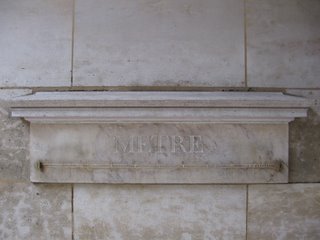
In the 1790's the French government decided that they probably ought to do something about standardizing the country's unit of measure. At the time people were using the foot, but the length of a foot, and the number of inches in it varied from region to region, and often from street to street. The government decided that the best way to define a standard unit of measure was by way of the "metre" (from Greek "metron" meaning "a measure") defined as one ten millionth of the length of the Earth's Prime Meridian, which at the time passed through Paris. This is a great example of making something simple, very difficult. Judging on the measurements of the French scientists, this granite bar is representative of one metre. There were 16 of these bars made and placed in the busiest of Paris's neighborhoods, with the bar calibrated in tenths so that those needing to measure could do so. Of the 16 this is the only one remaining (half of one is on the other side of Paris). I 'd wager that the reason this one is still around is that it is awfully hard to find, and it happens to be in a little nook in the wall of the Senate building. By the way, this same measurement of the meter was adopted by the rest of Europe, and is still considered the meter that we use today.
No comments:
Post a Comment